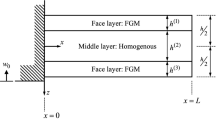Abstract
The paper is devoted to the experimental assessment of the Refined Zigzag Theory (RZT) for the free-vibration analysis of sandwich beams. To investigate the model performance, the effect of the face-to-core stiffness and thickness ratios as well as beam slenderness are taken into consideration. For comparison purposes, the results obtained by using the Timoshenko’s beam model, adopting an adequate shear correction factor, are given. The RZT demonstrates its remarkable accuracy with respect to the Timoshenko’s beam theory even when the latter is used with the ad-hoc calculated shear correction factor.







Similar content being viewed by others
References
Noor AK, Burton CW (1996) Computational models for sandwich panels and shells. Appl Mech Rev 49:155–199
Gherlone M, Di Sciuva M (2003) Analytical models for the homogenization of sandwich honeycomb cores. In: Proceedings of 17th AIDAA national congress, pp 457–466
Madabhusi-Raman P, Davalos GF (1996) Static shear correction factors for laminated rectangular beams. Compos Part B 27B:285–293
Di Sciuva M (1983) A refinement of the transverse shear deformation theory for multilayered orthotropic plates. In: Proceedings 7th AIDAA national congress, pp 83–95
Di Sciuva M (1986) Bending, vibration and buckling of simply supported thick multilayered orthotropic plates: an evaluation of a new displacement model. J Sound Vib 105(3):425–442
Di Sciuva M (1987) An improved shear-deformation theory for moderately thick multilayered anisotropic shells and plates. J App Mech 54:589–596
Di Sciuva M (1992) Multilayered anisotropic plate models with continuous interlaminar stresses. Compos Struct 22(3):149–167
Tessler A, Di Sciuva M, Gherlone M (2007) Refinement of Timoshenko beam theory for composite and sandwich beams using zigzag kinematics. NASA Technical Report, NASA/TP-2007-215086
Tessler A, Di Sciuva M, Gherlone M (2010) A consistent refinement of first-order shear deformation theory for laminated composite and sandwich plates using improved zigzag kinematics. J Mech Mat Struct 5:341–367
Iurlaro L, Gherlone M, Di Sciuva M, Tessler T (2013) Assessment of the Refined Zigzag Theory for bending, vibrations and buckling of sandwich plates: a comparative study of different theories. Compos Struct 106:777–792
Gherlone M (2013) On the use of zigzag functions in equivalent single layer theories for laminated composite and sandwich beams: a comparative study and some observations on external weak layers. J Appl Mech 80(6):061004
Iurlaro L, Gherlone M, Di Sciuva M (2014) Bending and free vibration analysis of functionally graded sandwich plates using the Refined Zigzag Theory. J Sand Struct Mat 16(6):669–699
Versino D, Mattone M, Gherlone M, Tessler A, Di Sciuva M (2013) C0 triangular elements based on the Refined Zigzag Theory for multi-layered composite and sandwich plates. Compos Part B Eng 44(1):218–230
Eijo A, Oñate E, Oller S (2013) A four-noded quadrilateral element for composite laminated plates/shells using the refined zigzag theory. Int J Num Meth Eng 95(8):631–660
Gherlone M, Tessler A, Di Sciuva M (2011) C0 beam elements based on the Refined Zigzag Theory for multilayered composite and sandwich laminates. Compos Struct 93:2882–2894
Tessler A, Di Sciuva M, Gherlone M (2010) A homogeneous limit methodology and refinements of computationally efficient zigzag theory for homogeneous, laminated composite, and sandwich plates. Numer Meth Part Differ Equat 27(1):208–229
Tessler A, Dong SB (1981) On a hierarchy of conforming Timoshenko beam elements. Comput Struct 14:335–344
Iurlaro L (2014) Development of refined models for multilayered composite and sandwich structures: analytical formulation, FEM implementation and experimental assessment. PhD Thesis
Honda S, Kumagai T, Tomihashi K, Narita Y (2013) Frequency maximization of laminated sandwich plates under general boundary conditions using layerwise optimization method with refined zigzag theory. J Sound Vib 332:6451–6462
Author information
Authors and Affiliations
Corresponding author
Rights and permissions
About this article
Cite this article
Iurlaro, L., Ascione, A., Gherlone, M. et al. Free vibration analysis of sandwich beams using the Refined Zigzag Theory: an experimental assessment. Meccanica 50, 2525–2535 (2015). https://doi.org/10.1007/s11012-015-0166-4
Received:
Accepted:
Published:
Issue Date:
DOI: https://doi.org/10.1007/s11012-015-0166-4




